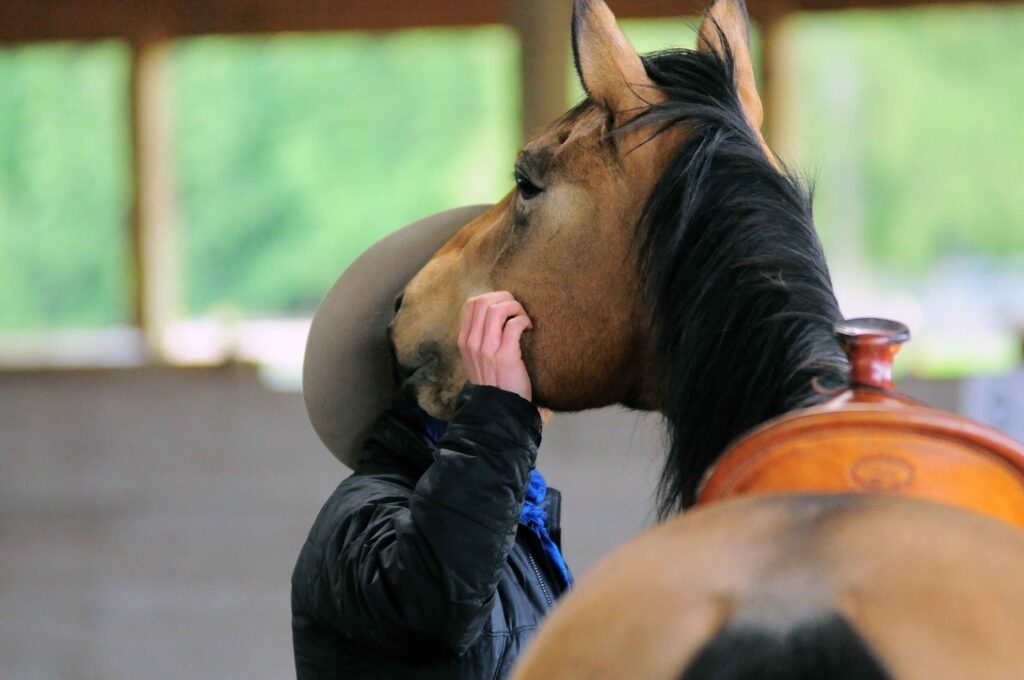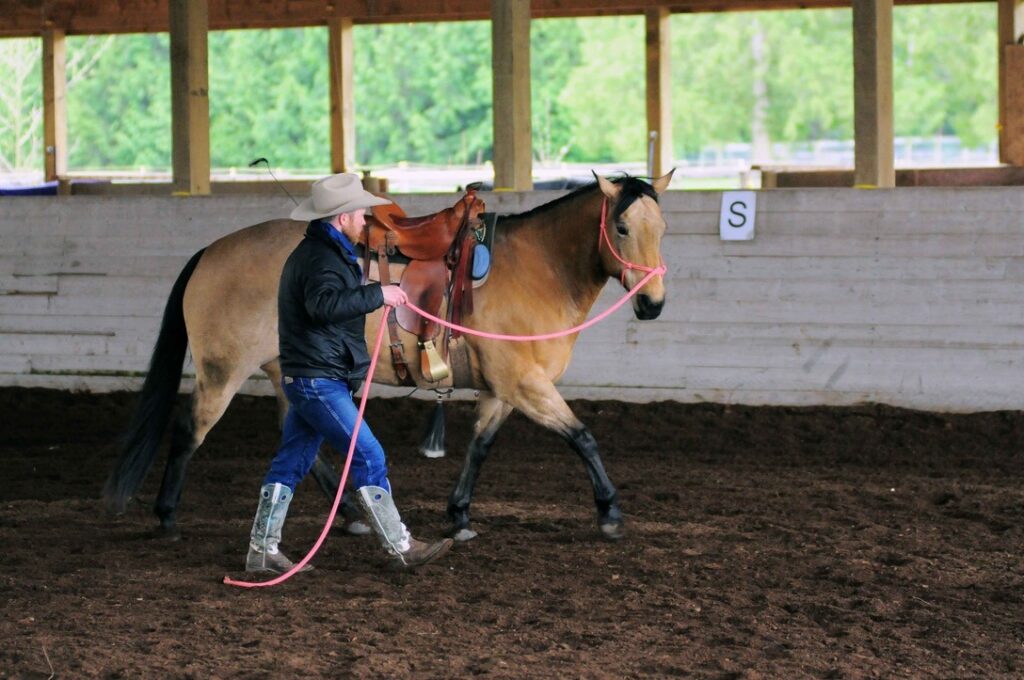Certain terms are commonly used in the horse world, yet many of them can have quite different meanings depending on the perspective and opinions of the speaker. “Softness” is one such term, so I would like to clarify the way I define this word.
When I speak about softness, I am referring to a willing responsiveness in the horse, free of any mental or physical tension. If you understand that softness in the horse is a prerequisite for cooperation, correct balance, and true athleticism, you recognize that it must be not only the foundation, but also a perpetual goal for our training.

Learning to focus on and value what is happening on the inside of the horse instead of what the body is doing is an important aspect of Relational Horsemanship. This is how they “tell us their secrets”, although it may look like this one is whispering some to me!
When you start to work on developing softness in the horse, your focus begins to change. Instead of mainly paying attention to the outside of the horse (what its body is doing), you are drawn into the inside of the horse, meaning what the horse is feeling and thinking. To achieve softness, you must continually feel and value what is happening within a horse.
Horses do not speak verbally, but they are always communicating how they feel, both mentally and physically. If you understand how to “hear” what they are saying, you will know if they are relaxed or tense, comfortable or worried, distracted or attentive, and much more. I wish that everyone who works with horses could have the opportunity to gain an aptitude in this form of communication, as when we have that ability, we can help our horses in so many ways, and they in turn can give us their absolute best.
The first step in being able to hear your horse’s communication is recognizing that when a horse thinks, their thoughts are expressed within their muscles. If a horse becomes worried, their muscles will tighten up in preparation for taking some kind of self-preserving action. If a horse feels safe, their muscles will be loose and relaxed. Even engaged muscles performing athletically will have an elastic responsiveness in them, not tightness.

Keeping a soft feel in yourself is critical to getting a soft feel in your horse. In this photo, I had asked the horse to soften with just the weight of two fingers, and as soon as I felt the horse let go, I released the lead.
Learning to feel what is going on in the muscles of a horse gives you a very important leg up, not only in communicating with a horse, but also in terms of safety, as you will be able to feel a worry in the horse before it turns into a buck, bolt or spook. You then have the opportunity to help the horse through that moment proactively, rather than having to react to the problem. Good training is very much about being early, which allows you to preserve the trust and peace that forms the core of Relational Horsemanship.
As for how you go about learning to feel what is happening in your horse’s muscles, one of the best ways to do this is to redefine the purpose of your lead rope in your ground work and the reins when riding. In Relational Horsemanship, the lead rope and reins are not for steering or correcting/criticizing the horse — they are to feel whether the horse feels safe and comfortable with your requests or not. This starts by making a change within your mind. Let go of the concept that your lead/reins are there to make your horse do or not do something. Instead, nurture the idea that they are there for you to sense what your horse is feeling. When you change the purpose of the lead/reins in this way, you will start to feel the horse’s mind as it manifests through his muscles.
This can begin very simply in your ground work. While your horse is walking or even standing, pick up a light connection on the lead and feel what happens in the horse’s poll/jaw. Does it yield with an easy flow in the direction of your connection, or do you feel tension, heaviness, or resistance? If you aren’t feeling a soft response, the first thing to check is what is going on inside yourself. If you want softness in your horse, there must be a corresponding softness within you. If you are physically tense or bracing in your request, the horse is likely to brace too. If you are nervous or worried, the horse will pick up on that as well. While we want to feel what is happening inside the horse, we must remain aware that the horse can already feel whatever is going on inside of us, and it matters deeply to them. This is another reason to start this work while standing or walking, then only progress to feeling for softness in faster gaits when you and your horse both feel safe and relaxed doing so.

Once a horse discovers that softness actually feels good, they will start to offer it more and more quickly when you ask for it.
So, ensure that your mind and body are relaxed, then pick up the rein with enough contact that you can sense the muscles in your horse. If you feel tension or resistance, the key is to stay calm, then simply wait for the horse to take on the peace you are offering and let the tension dissolve into a relaxed feel. That is softness, and it happens when the horse begins to manifest the calm energy you are presenting. When they do so, they discover that softness is actually a much more comfortable state than tension, both mentally and physically.
Being able to feel tension in the horse and melt it away into softness is the essence of Relational Horsemanship, and it is a lifeline that allows you to support the horse through the training process while also increasing your safety in situations that might stress your horse. Please remember, however, that as you are looking to develop softness, you are not trying to force the horse to make this change. Force will only make the horse become more defensive and defeat your aim. Stay calm and wait for the feel to become softer. Soon this change will happen more and more quickly, and you will have gained a very important skill within your horsemanship.

My mate and I are working on softness. She is troubled emotionally and has exploded
Several times , and has many triggers . There are times when she will walk softly when being lead under halter , and times when the lead will tighten and have tension. She will stop , raise her head , and not want to continue moving forward . This is happening almost every time we walk into the arena. Can you please give me some insight on how to help her through this . My previous trainer has told me to just keep walking and “make her follow” by actually pulling her along . I do not think that method is effect or solving any issue with in her . I have been stopping with her , waiting for her to connect , lower her head , and pull her towards me with my intent and energy . It does work eventually ., however , the pattern of behavior is continuing.
Thank you for your time !
Hello Stephanie,
The arena may make her a little nervous, I would work towards asking her to soften to the lead at the gate and don’t worry if she needs a minute. It’s not an emotion or disobedience. Just give her a pat on the neck, wait till she is ready then continue on. I like to think of a situation where you needed a minute when something was bothering you. If someone held space for that, you would feel safe. Soon it will diminish! Good luck and great question!
Thank you Josh. My mare has had a forward problem that’s been very difficult for me. Now at year two I feel like there is good progress. All the changes had to come from me not her. I am going to try getting even lighter and see if she can get softer. Great suggestions. Thx.